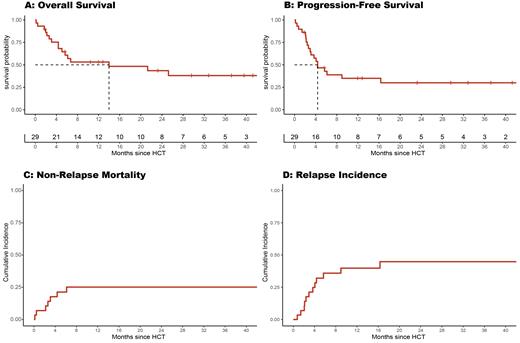Abstract
Background
Approximately 60% of patients with aggressive large B-cell lymphoma (ALBCL) treated with anti-CD19 chimeric antigen receptor T-cell (CAR T) will ultimately progress or relapse. Allogeneic hematopoietic cell transplantation (Allo-HCT) is a potentially curative treatment for lymphoma patients who relapse after CAR T-cell therapy. However, the efficacy and toxicity profile of allo-HCT following CAR T in aggressive lymphoma patients are not well defined. Herein, we report our experience.
Methods and patients
A total of 29 adult patients (median age 45 years [IQR 40-55]) who received allo-HCT for ALBCL between 2017 to 2021 were included. All patients were previously treated with anti-CD19 CAR T-cell (academic CD28-costimulatory domain product [n=23, 79%]; tisagenlecleucel [n=6, 21%]). Twenty-five (86%) and 4 (14%) had a diagnosis of DLBCL and PMBCL, respectively. Median number of previous therapies before CAR T was 3 (IQR 2-4). Eight (28%) patients underwent a previous autologous HCT. No patient underwent a previous allo-HCT. Median hematopoietic cell transplantation-specific comorbidity index (HCT-CI) was 3 (IQR 2-3). Six (21%) patients had a Karnofsky performance status ≤ 80%.
Allo-HCT was performed at a median of 4.1 months (IQR 2.2-5.4) post CAR T, with the majority of patients (48%) receiving transplant as first-line post CAR T. Reasons for allo-HCT were consolidation of complete response (CR) to CAR T in high-risk disease (n=4, 14 %), partial response (PR) to CAR T (n=7, 24%) and relapse /progression after CAR T (n=18, 62%). Disease response before allo-HCT was CR (n=11, 38%), PR (n=11, 38%) and progressive disease (n=7, 24%). Donors were matched siblings (n=13, 45%), matched unrelated (n=9, 31%) and mismatched unrelated /haploidentical donors (n=7, 24%). Myeloablative and reduced-intensity conditioning regimens were given in 13 (45%) and 16 (55%) patients, respectively. Methotrexate-based graft versus host disease (GVHD) prophylaxis was used in 20 (69%) patients. Antithymocyte globulin and post-transplantation cyclophosphamide were administered in 13 (45%) and 5 (14%), respectively.
Results
Median follow-up was 33 months (IQR 13-41). Neutrophil engraftment rate was 93% (two early deaths before engraftment due to infection and multi-organ failure). Two-year overall survival (OS) and progression-free survival were 44% (95% CI: 28-68) and 30% (95% CI: 17-55), respectively. Two-year cumulative relapse incidence and non-relapse mortality were 45% (95% CI: 25-63) and 25% (95% CI: 11-43), respectively (Figure). In a univariable Cox regression, factors significantly associated with a shorter OS were number of interim therapies between CAR T and allo-HCT (Hazard ratio [HR] 2.2 [95% CI: 1.3-3.9], p 0.006) and the length of time between CAR T and allo-HCT (HR 3.8 [95% CI: 1.2-12.1], p 0.02). Best response to CAR T and disease response before allo-HCT were not significant risk factors for a shorter OS.
High rates of grade ≥ 3 hyperbilirubinemia (total bilirubin >3 ULN) and hepatic sinusoidal obstruction syndrome (SOS) were observed in 10 (35%) and 5 (17%) patients, respectively. These liver insults were not contributed to acute GVHD. All patients with SOS were treated with defibrotide and two patients died from related complications. Interestingly, 4/5 patients with SOS were conditioned with fludarabine and thiotepa.
One-year cumulative incidence of grade II-IV acute GVHD was 34% (n=10; 95% CI: 18-52). Notably, 6 patients had grade IV acute GVHD, 4 of them were refractory to corticosteroids and 3 patients died due to acute GVHD. Two-year cumulative incidence of chronic GVHD was 23% (n=5; 95% CI: 7-46). Chronic GVHD was considered extensive in 4 of them.
Bloodstream bacterial infection was documented in 11 (38%) patients. Invasive fungal infection occurred in 6 (21%) patients and included brain aspergillosis, cutaneous aspergillosis, 2 lung aspergillosis, hepatosplenic candidiasis and an ocular mucor mycosis.
Conclusion
Allogeneic hematopoietic cell transplantation is feasible after failure of CAR T-cell therapy in aggressive lymphoma, although with a relatively high rate of SOS and severe acute GVHD in these heavily pretreated patients. Overall survival is encouraging with approximately 30% of patients remaining alive and disease-free at two years. Larger scale studies are required to better define the role of allo-HCT in this setting.
Shouval: Medexus: Consultancy. Jacoby: NOVARTIS: Honoraria, Membership on an entity's Board of Directors or advisory committees. Avigdor: Takeda: Consultancy, Honoraria; Janssen: Research Funding; BMS: Research Funding; Gilead: Consultancy, Honoraria; Pfizer: Consultancy, Honoraria.


This feature is available to Subscribers Only
Sign In or Create an Account Close Modal